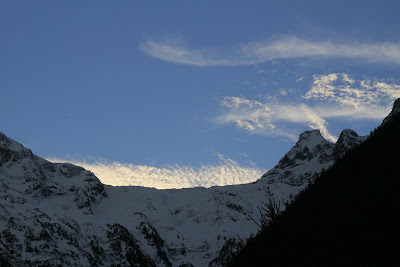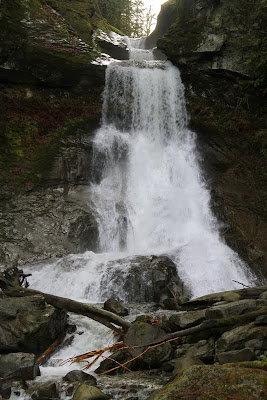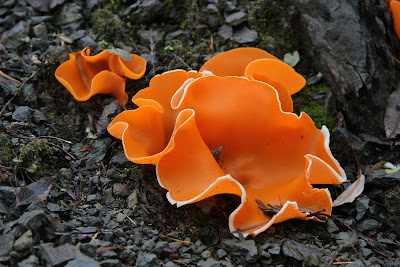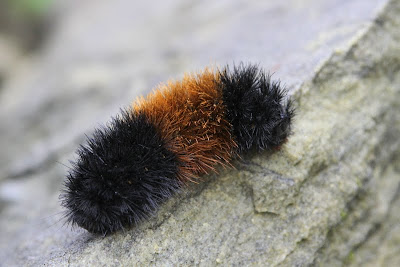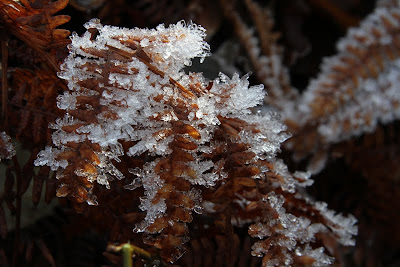I made two visits to Slide Mountain recently, one with son Edward and one with a group of school children who were studying fossils in their science classes and wanted to see some of the fossils at this amazing site. Slide Mountain is in the foothills of the North Cascades and overlooks the North Fork of the Nooksack River and the valley below with the mountains of the Canadian Coastal Range visible in the distance.
Nooksack Valley and Canadian Coastal Range
The day Edward and I went we met up with some of his co-workers and spent most of the day on the mountain. The weather started out sunny but turned cloudy making pictures of the slide area difficult, but on the second trip I managed to get some better photos. It was drier, too, the second time. The first time Edward and I had come home filthy after a very muddy scramble on the mountain and in the area of the slide.
Slide Mountain is named for its tendency to produce major landslides and the areas where we hunted for fossils were the sites of very old landslides, mostly overgrown with brush. The most recent landslide happened a few years ago on the side of mountain facing the Nooksack and its tributary, Racehorse Creek, and that is where we spent most of our time exploring and hunting for fossils uncovered by the slide.
The Racehorse Creek landslide happened on January 5, 2009, after a days
of warm stormy weather and rain (what we call here a Pineapple
Express). About 500,000 cubit feet of rock and earth slid down the
mountain and into Racehorse Creek temporarily blocking the Creek and two
days later causing a massive flood of water, rock and timber down
Racehorse Creek and into the North Fork of the Nooksack.
On both of these excursions we visited Racehorse Falls and the creek below and the photos show the debris from the landslide which scoured out the area of the falls as well. Before the landslide and flash flood the area was grown over with trees and brush and the falls were not that visible. Now the way to the falls is a scramble over old tree trunks and boulders but the falls are visible from quite a distance away.
Schoolkids at Racehorse Falls
Racehorse Creek Below the Falls
Racehorse Falls
Near Racehorse Falls
The landslide left a 350 foot cliff in the side of the mountain and
uncovered thousands of Eocene fossils, mostly of plants, though bird
tracks have also been found. The debris field itself is a jumble of
boulders and timber and the best place to look for fossils, though it
requires some serious scrambling, but the fossils can be found all over
the mountain and we looked in several other places as well.
Racehorse Creek Landslide
The mountain is formed of layers of soft carbonaceous shale, which quickly weathers and crumbles, and layers oif Chuckanut sandstone visible in the photo of the cliff. The fossils are found in both with inclusions of coal as well. This is a photo of a whole palm frond and pieces of other fronds in shale. The rock is around four feet long and several feet wide, to give an indication of scale, and many other of these fossils are massive.
Palm Fossils
Along with the numerous fossils of palm fronds, we found huge imprints of their trunks and smaller fossils of ferns and conifers and even a section of bark that had been turned to coal. The mountain must be made of fossils or so it seems when one is there. Every stone, every boulder, seems to have something on it or in it and it is for that reason a favorite place for field trips from the local University, Western Washington.
Palm Trunk Fossils
Fern Fossils
Conifer and Fern Fossils
Palm Bark Turned to Coal
Along with the fossils we found all kinds of interesting fungi, lichens and mushrooms and polypores and spent as much or more time photographing them as we did the fossils. I've done my best to identify them, but my identifications are in many cases tentative and I am happy to be corrected. Autumn is a good time for fungi anyway and the numerous dead trees destroyed by the landslide meant there were even more of them than usual.
Orange Peel Fungus
Golden Jelly Fungus
Mock Oyster Mushrooms
Rusty Gilled Polypores
Late Fall Oyster Mushrooms
Shaggy Scalycap
Gymnopilus picreus and Mycena monticola
Hairy Curtain Crust Fungus
Tubaria confragosa
Heath Waxcap
British Solider Lichens
Mealy Pixie Goblet Lichens
A few other finds included autumn leaves, frosted leaves and fern fronds, and a Woolly Bear Caterpillar, which I learned develops in autumn, freezes over the winter, unthaws in the spring and then turns into the pupa of a moth. It produces a kind of antifreeze that keeps it from death when it is frozen. There is always something to learn and always something amazing and new and this place was a learning experience.
Woolly Bear Caterpillar
Autumn Leaves
Frost

